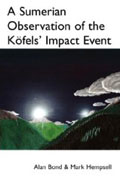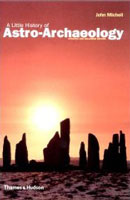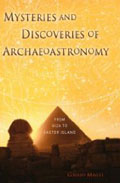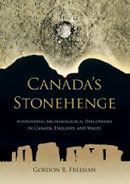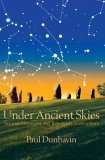|
With satellite imagery increasingly being used for archaeological investigations The Morien Institute has decided to report
discoveries in our Astro-Archaeology news archive
Likewise, many ancient legends that have previously been dismissed as purely “mythological” are now proving to be based on fact, and so
The Morien Institute has decided to also report these new
discoveries in our Astro-Archaeology news archive
Alongside these will be material about ancient astrological beliefs which were inextricably inter-linked with archaic astronomical science
“8000 year-old Sun temple found in Bulgaria”
December 15, 2010, The Sofia Echo, Bulgaria
“The oldest temple of the Sun has been discovered in northwest Bulgaria, near the town of Vratsa, aged at more then 8000 years, the Bulgarian National Television (BNT) reported on December 15 2010.
The Bulgarian ‘Stonehenge’ is hence about 3000 years older than its illustrious English counterpart.
But unlike its more renowned English cousin, the Bulgarian sun temple was not on the surface, rather it was dug out from under tons of earth and is shaped in the form of a horse shoe, the report said.
The temple was found near the village of Ohoden. According to archaeologists, the prehistoric people used the celestial facility to calculate the seasons and to determine the best times for sowing and harvest.”
[Full Story]
“Cahokia Mounds & the remnants of a sprawling metropolis”
November 12, 2010, Examiner, USA
“Located on an expansive flood plain near the confluence of the Illinois, Mississippi and Missouri rivers is the preserved central section of the largest prehistoric Indian city north of Mexico.
As a World Heritage Site, Cahokia Mounds includes 68 hand-packed earthen mounds, a wooden sun calendar, several burial tombs and a central plaza, all spanning across 2,200 acres (880 ha). There are 80 remaining mounds in total, out of 120 known.
An artist’s depiction of Cahokia Mounds at its peak
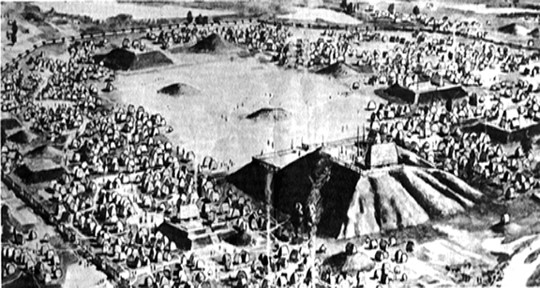
, Brad Olsen
The city at its height in 1200 CE was home to at least 20,000 residents, but may have been as high as 50,000. At that time Cahokia had a larger population than the city of London, England..
Expansive agricultural fields encircling the city supported the citizens. Cahokia is also the renowned birthplace of archeoastronomy, the science of identifying astronomical alignments within the architecture of prehistoric structures.
Archeoastronomy became a new component of North American archaeology following Warren Wittry’s 1964 discovery of several woodhenges at Cahokia.
Wittry demonstrated that these wooden features were solar observatories and determined that its builders had an integral understanding of celestial movements.”
[Full Story]
“‘Unique’ astronomical object reveals Ancient Egyptians
kept close tabs on the Big Dipper”
November 09, 2010, Heritage Key, UK
“New research on a 2,400 year old star table shows that the Ancient Egyptians kept close tabs on the Big Dipper, monitoring changes in the constellation’s orientation throughout the course of an entire year.
The Big Dipper is composed of seven stars and is easily viewable in the northern hemisphere. Its shape looks like a ladle with a scoop attached. Ancient Egyptians represented it as an ox’s foreleg.
Professor Sarah Symons, of McMaster University in Hamilton Canada, carried out the new research. She presented her results on Sunday at an Egyptology symposium in Toronto.
The star table she analyzed is located inside the lid of a 2,400 year old granite sarcophagus, constructed in the shape of a bull, which is now in the Egyptian Museum.
Inside the sarcophagus there is an astronomical table, a section of which has rows that show the foreleg of an ox in a wide range of different positions. “
[Full Story]
“The Americas: The old New World”
November 09, 2010, The Guardian, UK
“Across the Americas, cultures tailored their calendars to mark the movements of the sun, moon and stars.
The earliest public architecture was the product of collective endeavours to control the powerful invisible natural forces that govern seasonal changes and the success or failure of crops.
The position of temples was often linked to the rhythms of the cosmos.
Priests were charged with the task of aligning sacred sites and temples such as the kalasasaya (sacred enclosure) at Tiwanaku and the templo mayor (great temple) at Tenochtitlan on key sunrises and sunsets. They give us a glimpse of the impressive knowledge of pre-Columbian mathematics and astronomy.
They give us a glimpse of the impressive knowledge of pre-Columbian mathematics and astronomy.”
[Full Story]
“Comets triggered Aboriginal tales of doom”
October 18, 2010, ABC Science News, Australia
“Australia’s first people viewed comets as portents of doom, a new study of Aboriginal astronomy has found.
Writing on the pre-press website arXiv.org, Duane Hamacher from Sydney’s Macquarie University who led the research, says Aboriginal people developed an extensive culture regarding the night sky with stories and detailed observations.
‘Different Aboriginal groups had different seasons linked to certain stars which correlated to the availability of certain food sources, or when Indonesian fishermen would come to trade’, says Hamacher.
‘Aboriginal societies typically associated comets with fear, death, omens of sickness, malevolent spirits and evil magic, which is consistent with many other cultures around the world’.
‘There is a place called comet rock in the Kimberley with pictures that look like a comet and there were stories about a star with trails that fell out of the sky into the ocean, causing massive tsunamis’.”
[Full Story]
“Archaeologists may find Khawja Nasir observatory
at Alamut Castle”
October 17, 2010, Tehran Times, Iran
“Archaeologists working at the Alamut Castle have recently discovered ruins of a structure which they say may be of an observatory that had been built by the Iranian polymath Khawja Nasir ad-Din Tusi at the castle during the 13th century.
‘We have found three hatches opening toward the southeast where stars begin shining at the end of the day’, Alamut Research Center Director Hamideh Chubak told the Persian service of the Fars News Agency on Saturday.
‘The general structure of the Alamut Castle possesses characteristics that indicate it had also been used for observatory activities’, she said.
Additionally, Chubak said that astronomers’ tools were previously discovered in the castle.”
[Full Story]
“Russian claims to uncover ‘Caucasian Stonehenge'”
October 13, 2010, The Associated Press, USA
“A Russian archaeologist claimed Tuesday to have found the well-preserved ruins of a ‘Caucasian Stonehenge’ built by a previously unknown Bronze Age civilization in southern Russia.
Andrey Belinskiy said that unusual circular settings made of stones were found at one of some 200 settlements that date back to 1600 B.C. and are located in the North Caucasus mountains.
‘Any structure of unusual shape could be related to a calendar’, Belinskiy told The Associated Press adding that the structures did not resemble barns and houses his expedition found in other settlements.
He said that ceramics found in the area had ornaments that suggested that their creators were familiar with astronomy and calendars. The civilization he found left no written records and its ethnic origins are unknown, he said.”
[Full Story]
“[Mayan] Apocalypse Calendar May be Off”
October 07, 2010, Lab News, USA
“The Maya prophecy predicting the 2012 end of the world may be off by 50 to 100 years or more, according to a new book by Gerardo Aldana, associate professor at the University of California at Santa Barbara.
Aldana’s research, in general, focuses on reconstructing Mayan astronomical practices, which for the most part can be recovered from their applications.
A new book questions the accuracy of the Maya calendar
including the 2012 prophecy and other historical dates
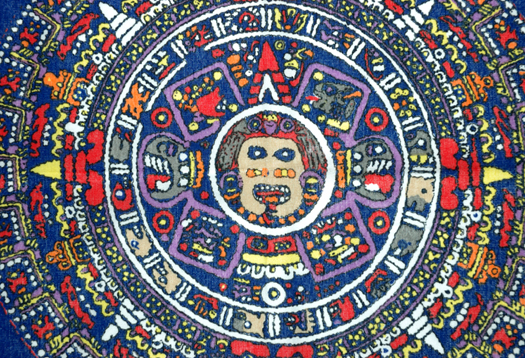
, Futurity / Lab News
Most of the data found in the archeological record amount to ritual events timed by astronomical phenomena; architecture oriented to observable astronomical events; or numerology tying together science, history, and religion with hieroglyphic inscriptions carved in stone.
‘One of the principal complications is that there are really so few scholars who know the astronomy, the epigraphy, and the archeology’, says Aldana”
[Full Story]
“Mexican Archaeologists from INAH Explore
Prehispanic Observatory in Tabasco”
October 01, 2010, Art Daily, USA
“Researchers of the National Institute of Anthropology and History (INAH) study a Prehispanic monticule known as Structure 12, at San Claudio Archaeological Zone in Tabasco, which may have had been used as an astronomical observatory to register the Sun movements at solstices when this city was dwelled by Maya people, between the first centuries of the Common Era to year 900.
According to archaeologist Jose Luis Romero Rivera, director of the INAH project at the site located in Tenosique municipality, Structure 12 is a 2.5 meters high base, with other 2 bases slightly tallest at the north and south extremes.
‘It is probable that people accessed the structures by the esplanade or central yard. It is a stone construction with batter walls and rounded corners resembling the Peten style but of smaller dimensions’.
‘Other unique feature is its orientation: all structures present an 11 degrees deviation to the northeast, while number 12 is deviated by 25°; the difference allows us to assume it had an astronomical function.’“
[Full Story]
“Australian Aborigines ‘world’s first astronomers'”
September 17, 2010, Yahoo News / AFP, USA / France
“An Australian study has uncovered signs that the country’s ancient Aborigines may have been the world’s first stargazers, pre-dating Stonehenge and Egypt’s pyramids by thousands of years.
Professor Ray Norris said widespread and detailed knowledge of the stars had been passed down through the generations by Aborigines, whose history dates back tens of millennia, in traditional songs and stories.
‘We know there’s lots of stories about the sky: songs, legends, myths’, said Norris, an astronomer for Australia’s science agency, the Commonwealth Scientific and Research Organization (CSIRO).
‘We wondered how much further does it go than that. It turns out also people used the sky for navigation, time-keeping, to mark out the seasons, so it’s very practical.’.
‘People were nomadic so when Pleiades, the Seven Sisters star cluster, was up they would move to where the nuts and berries are. Another sign and it would be time to move to the rivers to fish for barramundi, and so on’“
[Full Story]
“Astrological Scene Found on Egyptian Tomb Ceiling”
September 16, 2010, Discovery News, USA
“Brightly painted astrological scenes have emerged on the ceiling of an ancient Egyptian tomb, according to a statement released on Wednesday by the Supreme Council of Antiquities.
The scenes, which include a depiction of the sky goddess Nut, have been found in the burial chamber of a Nubian priest in the el-Asasif area on the west bank of Luxor.
The astrological mural found on the ancient tomb ceiling in Egypt
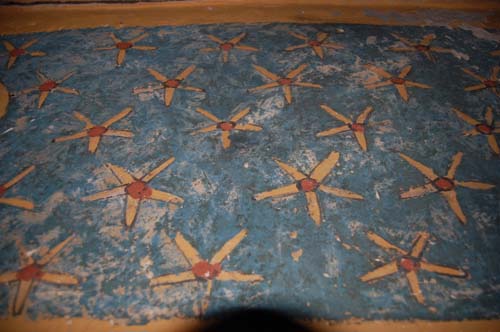
, Supreme Council of Antiquities, Egypt
‘The chamber was found at the bottom of an eight meter deep burial shaft’, Zahi Hawass, Secretary General of the Supreme Council of Antiquities (SCA), said.
The room is in very good condition and contains beautiful painted scenes in vivid colors. Blue and yellow dominate the ceiling, as the goddess Nut welcomes with raised arms the body of the deceased.”
[Full Story]
“Study shines light on Indigenous star-gazing”
September 16, 2010, ABC News, Australia
“Ancient Aboriginal people may have been the world’s first astronomers, a CSIRO study says.
Professor Ray Norris, who will deliver his findings at an astronomy, space and science lecture in Townsville in north Queensland today, says Indigenous Australians used the rising and setting of particular stars to read tides and harvest food.
‘One of the most interesting sites I found down in Victoria is a big stone circle of about 50 metres across and this seems to indicate the places along the horizon where the sun sets on mid-winter’s day, mid-summer’s day and equinox’, he said.”
[Full Story]
“How Halley’s Comet sightings changed history
over the past 2500 years”
September 13, 2010, io9, UK
“Ancient Greek texts reveal the earliest recorded sighting of the solar system’s most famous comet 2,500 years ago. Since then, Halley’s Comet has repeatedly cameoed in history, getting credit for toppling armies, birthing empires, and even killing Mark Twain.
Halley’s Comet is the most famous of the short-period comets, which are comets that complete their eccentric orbits in 200 years or less.
Astronomers recently modeled the comet’s approach in 466 BC, then looked for ancient texts that matched its probable appearance.
The previous earliest recorded appearance – or, as it’s more technically known, apparition – was by Chinese scholars noting the passage of the comet in 240 BC, which is three apparitions later than the 466 BC event.
After these first recorded appearances in 466 and 240 BCE, Halley’s Comet starts appearing with regularity every 75 or 76 years. Babylonian tablets mark its apparitions in both 164 and 87 BCE, and that second appearance may actually have been recorded in the local currency.
A coin featuring the Armenian king Tigranes the Great
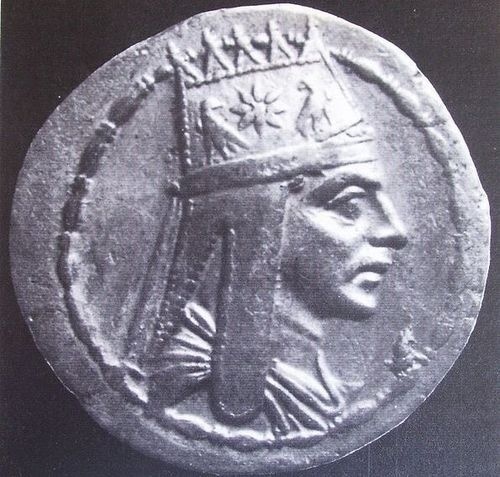
, io9
A coin featuring the Armenian king Tigranes the Great features a star with a curved tail on his crown, and there’s some thought that this is meant to be Halley’s Comet.”
[Full Story]
“Nebra sky disk discarded because of
volcanic ash, scientists say”
August 23, 2010, Earth Times, UK
“A catastrophic volcanic eruption spewing huge clouds of ash about 3,600 years ago was behind the burial of the Nebra sky disk, one of the most spectacular archaeological finds in recent years, according to scientists at Mainz and Halle-Wittenberg universities in Germany.
The 3,600-year-old disk, discovered in 1999 near the town of Nebra in the eastern German state of Saxony-Anhalt, is the oldest known representation of the night sky.
It is thought by some to have been used as an astronomical clock to determine when to add a thirteenth month synchronising the lunar calendar with the solar year.
The disk would be held against the sky, and when the position of the celestial objects matched those on the disk, the intercalary month would be added.
Scientists said the disk became worthless after the eruption on the Mediterranean island of Thera – north of Crete and also known as Santorini – which ejected ash that obscured the sky all the way to Central Europe for 20 to 25 years.”
[Full Story]
“The ancient meteorite cult of Estonia”
June 07, 2010, io9, UK
“Somewhere between 7,500-4,000 years ago, a meteorite fragmented over Estonia’s Saaremaa island.
The meteorite hit with a force comparable to Hiroshima and left nine impact craters, including the 110-meter Kaali crater.
Locals worshiped this hole as holy.
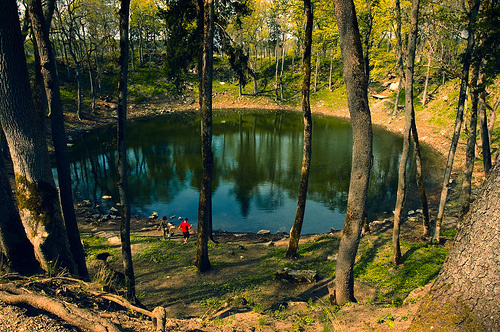
, CarlosJ’s Flickr / Atlas Obscura / io9
Simply known as Kaali crater, the largest crater (which measures 110 meters across) is believed to have been a sacred site for many centuries, in part due to its cosmic origin.
Surrounding Kaali crater are the remains of an immense stone wall from the Late Bronze Age, stronger than any similar structures in the region and providing clues to the crater’s use by ancient peoples.”
[Full Story]
“Where the ancients studied the moon and stars”
May 20, 2010, CNN, USA
“Macedonia is the youngest ancient country in the world and is full of relics of times past.
t has been part of all the great empires of history, from Roman to Ottoman to Byzantine and they have all left their mark with thousands of ancient sites.
The country has an estimated 4,485 archaeological sites from all historical periods, according to Pasko Kuzman, of the country’s Cultural Heritage Protection Office.
Jewel in the crown is Kokino, discovered in the mountains near Kumanovo in 2001 by local archaeologist Jovica Stankovski. It is a 4,000-year-old Megalithic Observatory used in the Bronze Age for studying the sun and moon.
The site, at an altitude of more than 1,000m and with a 100m diameter, is described as the “Macedonian Stonehenge” and is ranked by NASA as the fourth oldest ancient observatory in the world, after Abu Simbel in Egypt, Stonehenge in Britain and Angkor Wat in Cambodia.
Several stone seats, known as thrones and facing the east horizon were also discovered on the site.
Research showed that the observatory had a specific place for monitoring the stars and the sun, as well as specific holes through which the movement of the sun and the moon could be recorded.”
[Full Story]
“Could Djedefre’s Pyramid be a Solar Temple?
Not According to New Research by Baud”
May 11, 2010, Heritage Key, UK
“Dr Michel Baud of the Louvre Museum in Paris gave an interesting lecture last week about his excavations of a pyramid at Abu Roash.
The monument was badly preserved and its stone had been quarried in Roman times, but the certain details, such as its apparent solar connections, were still discernable. Earlier, Vassil Dobrev stated that the pyramid may actually be a solar temple. However, Baud dismisses these claims….
This passageway descends beneath the pyramid of Djedefre
It leads to the pharaoh’s funerary chamber
The pyramid was quarried in Roman times and little of it is left standing today
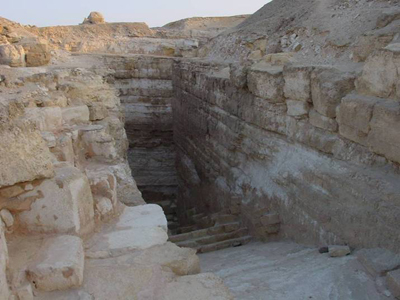
, Dr. Michel Baud / Heritage Key
There is solid evidence that this pyramid had solar ties to it, said Baud. ‘We found a huge number of statue fragments all in quartzite’, he said. ‘We know in Egyptian beliefs this stone was associated with the sun.’
Baud explained that purple is a colour associated with the rising sun and there is also some yellow on the fragments.
‘This is probably why we can say that in the reign of Djedefre there are strong solar connections’, he said.”
[Full Story]
“Firmament Watched at Huasteca Archaeological Site”
March 29, 2010, Art Daily, USA
“Interest in deciphering the sky, practiced during Prehispanic ages, is been retaken in 21st century at the Noche de Observacion Astronomica en Sitios Arqueologicos (Night of Astronomical Observation at Archaeological Sites), which first event took place in Tamtoc, San Luis Potosi in March 20th 2010.
Considered the capital city of Huasteca Prehispanic culture, Tamtoc was an important sky observation point, being Huasteca world view closely linked to star movements.
Centuries after, the interest of watching the sky and the path followed by stars is still present.
At the night of astronomical observation organized by the Archaeology Coordination of the National Institute of Anthropology and History (INAH), hundreds of persons were able to do as their ancestors and watch the firmament.”
[Full Story]
“Hypatia, Ancient Alexandria’s Great Female Scholar”
March 15, 2010, Smithsonian Magazine, USA
“An avowed paganist in a time of religious strife, Hypatia was also one of the first women to study math, astronomy and philosophy
One day on the streets of Alexandria, Egypt, in the year 415 or 416, a mob of Christian zealots led by Peter the Lector accosted a woman’s carriage and dragged her from it and into a church, where they stripped her and beat her to death with roofing tiles.
On the streets of Alexandria, Egypt, a mob led by Peter the Lector brutally murdered Hypatia, one of the last great thinkers of ancient Alexandria
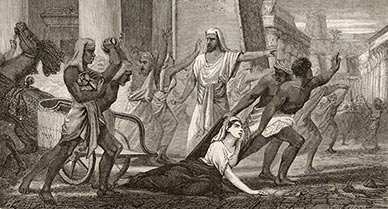
, Mary Evans Picture Library / Alamy / Smithsonian Magazine
They then tore her body apart and burned it. Who was this woman and what was her crime?
Hypatia was one of the last great thinkers of ancient Alexandria and one of the first women to study and teach mathematics, astronomy and philosophy.
Though she is remembered more for her violent death, her dramatic life is a fascinating lens through which we may view the plight of science in an era of religious and sectarian conflict.
Founded by Alexander the Great in 331 B.C., the city of Alexandria quickly grew into a center of culture and learning for the ancient world.
At its heart was the museum, a type of university, whose collection of more than a half-million scrolls was housed in the library of Alexandria.
The last known member of the museum was the mathematician and astronomer Theon — Hypatia’s father.”
[Full Story]
“Spring Equinox at Mnajdra Temples – Heritage Malta”
March 06, 2010, Gozo News, Malta
“Heritage Malta is once again organising a guided tour of the Mnajdra on Saturday 20th, Sunday 21st to mark the spring equinox.
Spring Equinox at Mnajdra Temples
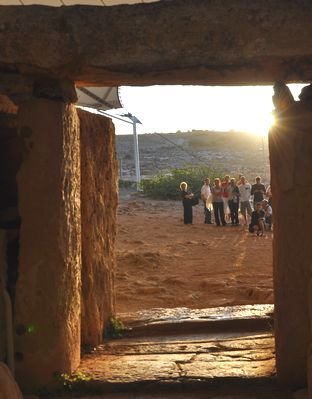
, Heritage Malta / Gozo News
Sunrise on the first day of each season underlines the relationship between the temples and celestial bodies.
Although it is not known for certain whether these orientations were intentional, they are so systematic that this is very probable.
In prehistoric agricultural societies, observation of the motion of the stars, the moon and sun could have been related to the changing seasons and times of planting and harvesting crops.
In a bid to provide an enhanced experience to visitors, only 40 visitors will be allowed during the event..”
[Full Story]
“Syria’s Stonehenge: Neolithic stone circles, alignments
and possible tombs discovered”
March 02, 2010, The Independent, UK
“For Dr. Robert Mason, an archaeologist with the Royal Ontario Museum, it all began with a walk last summer. Mason conducts work at the Deir Mar Musa al-Habashi monastery, out in the Syrian Desert.
One of the corbelled stone structures found in the Syrian desert. Archaeologists suspect that its an ancient stone tomb. In the front of it are the remains of a stone circle
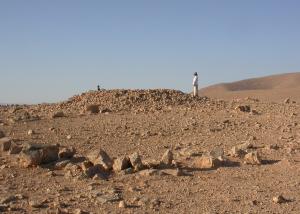
, Dr Robert Mason / The Independent
Dr. Mason explains that he ‘went for a walk’ into the eastern perimeter of the site – an area that hasn’t been explored by archaeologists. What he discovered is an ancient landscape of stone circles, stone alignments and what appear to be corbelled roof tombs.
From stone tools found at the site, it’s likely that the features date to some point in the Middle East’s Neolithic Period – a broad stretch of time between roughly 8500 BC – 4300 BC.
It is thought that in Western Europe megalithic construction involving the use of stone only dates back as far as ca. 4500 BC. This means that the Syrian site could well be older than anything seen in Europe.
At a recent colloquium in Toronto, Canada, Mason described his shock at discovering the apparent tombs, stone circles and stone alignments: ‘I was standing up there thinking, oh dear me, I’ve wandered onto Salisbury Plain’.”
[Full Story]
“Sunrise in the Abu Simbel sanctuary”
February 23, 2010, Al-Masry Al-Youm, Egypt
“Outside the Great Temple of Abu Simbel, a long line of people are waiting for a first chance to glimpse the sun’s rays as they fall on the faces of the statues of Pharaoh Ramses II, and the gods of creation and light, Ptah, Amen and Heru-khuti.
Light falls on the faces of statues
in the Abu Simbel temple during the Sunrise Festival
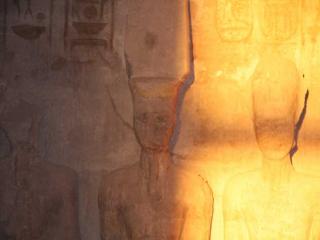
, Andrew Bossone / Al-Masry Al-Youm
At exactly 6:20 AM, the first beams of light fall on the sanctuary.
The Abu Simbel Sun Festival occurs biannually, on 22 October and 22 February, dates on which the sun shines directly into the temple’s sanctuary.
Many people wait to go inside the sanctuary and two troupes perform music and dance for about an hour until officials allow the visitors to enter.
Some say the sun shines in this way twice per year to commemorate the coronation and birthday of Ramses, which would indicate that the temple was built to honor the pharaoh on these days specifically.”
[Full Story]
“A Tree Carving in California: Ancient Astronomers?”
February 09, 2010, Time Magazine, USA
“Though local lore held that the so-called ‘scorpion tree’ had been the work of cowboys, paleontologist Rex Saint Onge immediately knew that the tree was carved by Indians when he stumbled upon it in the fall of 2006.
The counterclockwise rotation of stars around Polaris as viewed from Painted
Rock in Carrizo Plain, Calif. The glyph on the ‘scorpion tree’ appears
to portray Ursa Major in relation to Polaris
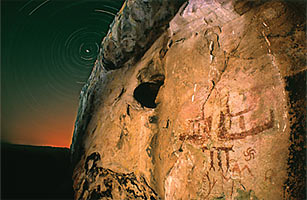
, Rick Bury / Time Magazine
Located in a shady grove atop the Santa Lucia Mountains in San Luis Obispo County, the centuries-old gnarled oak had the image of a six-legged, lizard-like being meticulously scrawled into its trunk, the nearly three-foot-tall beast topped with a rectangular crown and two large spheres.
‘I was really the first one to come across it who understood that it was a Chumash motif’, says Saint Onge, referring to the native people who painted similar designs on rock formations from San Luis Obispo south through Santa Barbara and into Malibu.
Amazingly, Saint Onge had just identified the West Coast’s only known Native American arborglyph, one long hidden behind private property signs. But the discoveries didn’t stop there.
After spending more time at the site, Saint Onge realized that the carved crown and its relation to one of the spheres was strikingly similar to the way the constellation Ursa Major — which includes the Big Dipper — related to the position of Polaris, the North Star.”
[Full Story]
“Amazon revolution? Researchers unearth lost cities”
February 01, 2010, CTV News, Canada
“One of the many Hollywood films that will hit theatres this year is “The Lost City of Z”, in which a group of explorers set out to find a colleague who vanished in the Amazon rainforest.
Based on a true story, the movie stars Brad Pitt as Percy Fawcett, a world-famous British explorer who disappeared in 1925, during an expedition to find the mythical city of El Dorado, which Fawcett codenamed ‘Z’ to keep his plans secret.
Some of the 260 ancient earthworks located in the Amazon basin by archeologist Denise Schaan and her colleagues, which are challenging traditional assumptions about the region’s history
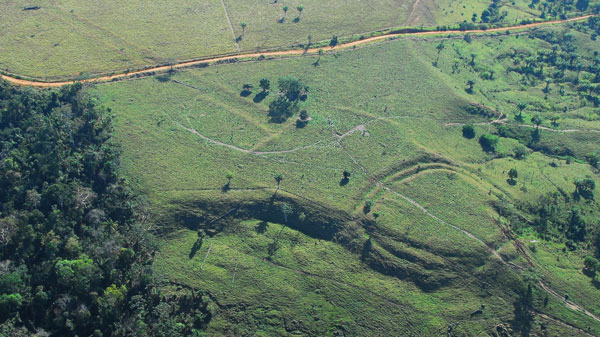
, Denise Schaan / CTV News, Canada
The premise of the movie, and its name, are taken from a book by David Grann, who retraced Fawcett’s route through the Amazon to investigate what happened to him.
Along the way, Grann learned of a group of archeologists who are unearthing evidence that, just as Fawcett believed, there were indeed large communities thriving in the Brazilian rainforest before Europeans arrived.
As the evidence mounts, it’s challenging conventional wisdom of the Amazon as a place so inhospitable it could only support small, nomadic tribes.
Instead it seems that large, complex societies may have tamed parts of the Amazon centuries before Spanish explorers sailed across the Atlantic. As that idea gains momentum, it’s also gaining more attention beyond archaeological circles.
‘There is now becoming, not just in the scientific and academic work but in the public world, a sense of the breadth of these discoveries’, Grann told CTV.ca from New York.
‘There is now becoming, not just in the scientific and academic work but in the public world, a sense of the breadth of these discoveries’.
Archaeologists came across a series of 127 granite blocks on a Brazilian hilltop in 2006. Some of the blocks appear to be arranged astrologically, and may have been placed there as long as 2,000 years ago. The site has become know as the Stonehenge of the Amazon.”
[Full Story]
“Jebel Hafeet’s riddle written in stones”
January 25, 2010, The National, United Arab Emirates
“On the empty plain below Jebel Hafeet lie clusters of fist-sized rocks whose origins remain a mystery.
Theories range from them being representions of the night sky created by ancient tribes to random piles created during oil prospecting in the area.
From up close, they look like stones scattered about in a haphazard fashion.
Hasan al Naboodah, a history professor at UAE University, walks among
the piles of stone near Jebel Hafeet in Al Ain
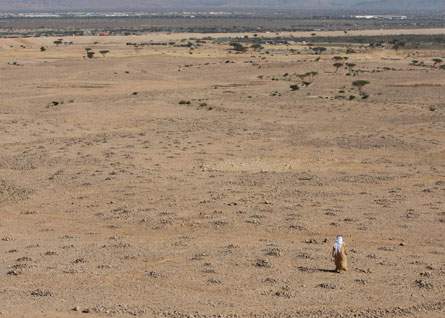
, Stephen Lock / The National, United Arab Emirates
But then, as one starts to climb the eastern slope of Jebel Hafeet and looks back, the perspective of distance reveals something strange.
The stones are, in fact, grouped in shallow piles that form a mysterious mosaic across the flat plain fringing the mountain.
Some are grouped together to form low, circular pyramids, positioned at almost equal distance from each other.
Others are arranged into parallel rectangular shapes. In addition to stones, some of the piles have pieces of coral.
‘There are many theories about these piles, some more mystical, and others less romantic’, says Prof al Naboodah.
‘Given their careful design and wide span of the terrain, they could have been aligned with the stars, as the stars were used by our ancestral tribes for geographical landmarks and for marking down the seasons.’.
Websites are dedicated to the rocks, with some photographs on Google Earth adding to speculation about their mysterious origins.”
[Full Story]
|













